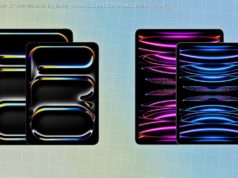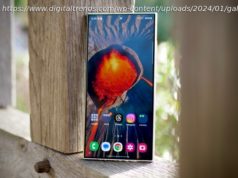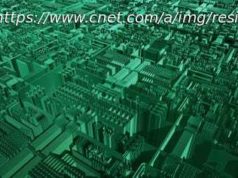Apple’s top-end tablet refresh is a philosophical shift of sorts; it opens up the iPad Pro to easy connectivity to new devices and positions the swipe as the navigation gesture of choice.
What’s there to see in the 2018 iPad Pro? While we’re at it, what’s there to « C »?
The 2018 refresh of Apple’s top-end tablet, aimed at creative-minded iOS users, is all about the see-and-C. As my colleague Sascha Segan opines, the switchover from the long-running Lightning port to USB Type-C as the sole physical port on the iPad Pro—a seemingly evolutionary move—is of greater import than a simple cable swap. It’s a philosophical shift of sorts.
Indeed, the 2018 iPad Pro will probably be seen as a, ahem, sea change for Apple’s tablet. It now has brute-force processing power that, if you believe Apple’s claims, packs more grunt than more than 90 percent of the Windows laptops sold in the last 12 months. (We’ll see when we test it.)
It opens up the iPad Pro to easy connectivity to new devices and dongle-free workflows that the Lightning-port-equipped iPad Pros made users do on Apple’s terms. And it sees the swipe as the navigation gesture of first resort; like late-model iPhones, the home button is gone, so you’ll need to learn some new moves. Not to mention the Apple Pencil; it gets a major makeover, too, for the first time.
I got my hands on of Apple’s new iPad Pros at its launch event in Brooklyn on Tuesday, alongside the 2018 reboots of the MacBook Air entry laptop and Mac mini compact desktop. Where to start? A tablet is nothing if not its display, so how about the screen? (The new-model iPad now comes in 11- and 12.9-inch varieties; the previous generation was 10.5 and 12.9 inches.)
Large screen bezels are good for some things. In the case of a tablet, they give you a spot on which to rest your thumbs, preventing you from tapping or swiping the screen by mistake. On a laptop, leaving the bezels big enough lets you keep crucial bits, like the webcam, in their righteous place above the screen. (Here’s glaring at you, Dell XPS 13 .) But big bezels can also be an eyesore. It’s a balance.
Apple seems to have executed that adroitly with the 2018 iPad Pros. First, the bezels are much reduced versus earlier iPads, which, in one case, allows for a same-size screen as before in a smaller-footprint device. In hand, the 11-inch iPad Pro feels like the older 10.5-inch model (which remains available); here’s a look at the two new tabs and the 10.5-incher together:
As for the 12.9-incher, it feels like all screen, no device, in your hand, and it’s possible to hold the tablet comfortably in one hand. You can’t say that about any comparably sized 2-in-1 laptop in tablet mode. Just mind your thumb; the bezels are trim enough to keep your digits out of trouble, but you’ll want to be sure you’re not blocking or smudging the lens of the user-facing camera, which handles a new addition: Face ID, Apple’s facial-recognition tech.
I saw several demos of Face ID, which governs logging in, on the iPad Pro at the launch event. While I could not try it with an iPad registered to my mug, it worked flawlessly for the reps onsite, even with the tablet rotated in any of the four orientations.
Part of the « all screen » effect comes from the removal of the home button. Logging in and returning to your home screen is now handled by Face ID and iOS 12’s enhanced gestures, including its ability to swipe down from upper-right to gain access to the Control Center, across the bottom to switch apps, and similar gestures.
But the screens themselves have seen some changes in their fundamentals. Apple now dubs the displays in the new iPad Pros as not just Retina panels but « Liquid Retina » ones, the same branding as on recent iPhones like the iPhone XR. Liquid Retina versus Retina seems just a branding exercise here; Apple didn’t elaborate on major advances in these panels (which, mind you, look great in person).
Part of the bezel reduction that happened on these new tablets is possible due to some clever masking in the corners of the screens, which now have rounded corners to match the rounded corners of the tablets themselves. (Note: The diagonal screen measurements assume that the rounded corners aren’t there and measure to a theoretical panel that’s a full rectangle.) The edges of the tablet have also been squared off and are no longer rounded, reminiscent of some earier iPhone designs, like the iPhone 4.
The end result is bigger screens in smaller spaces. The 11-inch iPad Pro fits its screen into the same footprint as the earlier 10.5-inch iPad Pro, while the 12.9-inch model is simply smaller than before, with the overall tablet about the size of a sheet of letter-size (8.5-by-11-inch) paper lying flat. They look whip-crack sharp, and a 120Hz refresh rate (versus the 60Hz refresh on the screens of the regular iPads) means motion video is silky. Fast-action gaming should benefit, too, though I did not have the opportunity to play any up close. (Apple did demo a spectacular NBA game from 2K Games that approximates console-level graphics on a tablet, which wowed the crowd.)
The core LCD technology has not changed, apart from a modest boost in raw pixel count and resolution, resulting in some one-off oddball native resolutions, with a 2,388-by-1,668-pixel 11-inch iPad Pro and a 2,732-by-2,048-pixel 12.9-inch one. All those numbers, though, as I’ll reiterate, translate to great.
What’s worse than losing your $99 Apple Pencil stylus that you bought to complement your iPad Pro? Losing your $129, refreshed- for-2018 Apple Pencil designed for the new iPad Pro. Luckily, Apple’s making it a bit easier to keep track of its pricey pen.
Of course, you might as well not mourn losing your original Pencil, because it won’t work with the 2018 iPad Pro. That’s a drag, considering the cost of the stylus. But the original Pencil used a physical Lightning charging connector under a cap at one end, while the 2018 reboot uses inductive (that is, wireless) charging, and there’s no Lightning port to be found on pen or iPad Pro.
You simply park the stylus along one of the long edges of the tablet, and magnets pull it into place and hold it firm; the iPad Pro then starts topping up the stylus’ battery. Now, magnets are magnets; I wouldn’t use this storage scheme as a way to hold the pen in place while you travel, with the tablet in hand. But it’s good enough to keep pen and tablet together on your desk, and it keeps the pen juiced up when it’s not in use. It won’t shake loose in ordinary jostling, but in a carry bag I’d expect the pen to slide off if other objects interfere.
Several other refinements reinvent the Pencil. It now has a double-tap function that shifts its mode, as Apple demonstrated to me in the Notes app; you two-tap with your index finger close to the tip to toggle that. That can, for example, change the default writing mode to eraser mode. Note that eraser mode wipes out your entire last stroke; it’s no gradualist eraser, unlike a real rubber tip. Also, the refreshed Pencil auto-pairs with the nearest iPad Pro.
I’ve seen demos of the augmented reality with the iPad Pro before ( see our hands-on report from WWDC), and Apple’s collaboration with Lego on AR play isn’t new. But I got to spend some time with a 12.9-inch iPad Pro and the Lego Playgrounds app.
This is a tech in its early days, but what it augurs is fascinating. In the demo, an elaborate Lego kit of a castle had been constructed from instructions, after which my demonstrator « scanned » the structure with the iPad Pro’s camera from within a Lego app. It recognized the structure and launched a game onscreen that overlaid the real castle with enemies, indicators, animated flames, and much more live detail.






